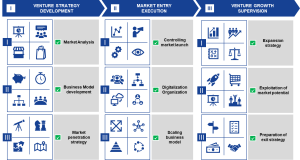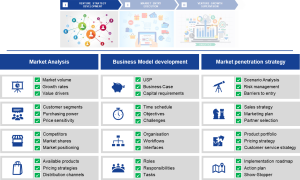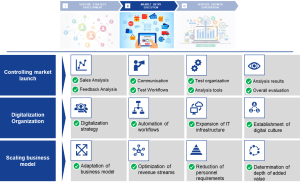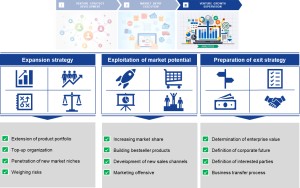
Venture-as-a-Service (VaaS) – Development of innovative business models
Professional support in building innovative digital business models
Digital business models require a specific setting of characteristics, know-how and competencies that are often not accessible in many classically structured organizations. In addition, a digital venture needs a special corporate and working culture to create the right atmosphere for the digital experts to perform at their best. Building such an entity and managing it efficiently is a challenge for many corporate and group leaders today. The following questions need to be answered:
- How to develop a sustainable digital business model with a good product/market fit?
- How can you recruit a team of digital experts?
- Which skills should be in-house and which can be outsourced?
- How can the digital venture be launched in an agile way and at the same time have all the skills to grow further?
- How should such a team be properly managed and incentivized?
- How should the performance of the company be measured?
Often, these are the success factors that decide the economic fate of a new business model. Obviously, digital venture development requires a well thought-out professional strategy to reduce the risk of making an investment that will not generate a positive ROI. Strategy development in the venture-as-a-service model focuses on three key phases, as shown in Figure 1:

Figure 1: Framework for the Venture-as-a-Service (VaaS) strategy development
Phase 1: Venture Strategy Development
The VaaS concept begins with the development of a holistic strategy for the business model. For which markets will the new business idea be designed? How is the business model to be built “from scratch”? Which measures should be used to develop the market? FOSTEC & Company develops pragmatic solutions to these questions as part of Phase I “Venture Strategy Development” (Figure 2). In this process, our experts carry out three systematic analysis steps with the goal of building a new business model from the idea to the market launch.

Figure 2: Phase 1: Venture Strategy Development
Venture Strategy Development begins with a thorough market analysis that includes both quantitative and qualitative components. The analysis framework includes the levels of market growth, customers, competitors and products. In the market growth analysis, we determine the growth rates in the respective market and define the value and growth drivers. Customers are analyzed based on their specific characteristics such as purchasing power and price sensitivity. We analyze future competitors based on their current market shares and positioning. We also evaluate their market strategies and identify their unique selling points. We then conduct a product portfolio analysis for the products and services available on the market, identify best sellers and evaluate the pricing strategies of the competition. In addition, we investigate which channels are used to market the products and services.
The results of the market analysis are incorporated into the structure of the new business model (middle pillar in Figure 2). Here, we develop the USP of the new business concept, determine the necessary capital requirements and create a detailed business case. At the same time, we develop an organizational design in terms of structure (organization chart) and workflows (process model) and define interfaces between departments and with external partners. In addition, we think through the personnel structure and define roles, responsibilities and tasks in the new organization.
With a final business concept, the strategy for market penetration can be developed. Starting with a scenario analysis, we examine realistic future options in the selected market and identify risks arising from the respective scenario. In addition, we investigate possible barriers to market entry. These can relate, for example, to capital requirements, special technologies or legal framework conditions. In parallel, we work on a sales strategy and create a marketing plan that already includes key performance indicators to measure the success of the marketing measures. Based on this, we determine the pricing policy, the product portfolio and the range of customer services. All the components described above are then incorporated into a structured implementation roadmap, which can be used to steer Phase II (see next chapter).
Phase 2: Market Entry Execution
In this step, we take over the operational implementation of the market launch of the developed business model and the controlling of its performance in the initial period. Based on the initial results, we develop a systematic approach to further digitize the business model and thereby increase the scalability of the concept. Here, as in Phase I, we also take three steps and intend to prepare the business model for further intensive growth (Figure 3).

Figure 3: Phase 2: Market Entry Execution
In the initial period after the market launch, we analyze the sales ramp-up and carefully collect the first customer feedback, with the aim of making rapid changes if necessary. On the organizational side, we design internal and external communications and check how efficiently processes are running within the company. We also observe how well the organizational design actually fits the developed business concept and how efficient the selected IT systems are. Subsequently, we develop a digitalization strategy to increase the scaling of the business model. We examine which processes and revenue streams can be further automated in order to reduce personnel requirements as revenue increases. We determine the optimal depth of value creation and find a balance between insourcing (own performance) and outsourcing (external services). These measures help to ensure the successful establishment of the business concept in the introductory phase and to prepare for further intensive growth. This growth requires specific steps that are consolidated in the final Phase III.
Phase 3: Venture Growth Supervision
The goal of this phase is to fully exploit the identified potential of the developed business model and eventually hand over the high-performing concept to a new business partner or investor (Figure 4).

Figure 4: Phase 3: Venture Growth Supervision
The expansion strategy is often not possible without extending the existing product portfolio. We therefore examine the meaningfulness of introducing new products and services into the current range. We analyze the placement of the new services in other market niches and weigh the associated risks. If this results in a need for additional personnel, we increase the size of the organization as part of our expansion strategy. To support the entire product portfolio on the market, we are preparing a marketing offensive and increasing the marketing budget accordingly. The efficiency of the marketing measures is ensured by operational measurement of the key performance indicators. Where necessary, we are opening up further sales and distribution channels and building up our best-selling products. The resulting increase in sales should also be reflected in a higher market share: If the market share remains constant while sales increase, the market is growing faster than our business model.
When the target has been reached and the market potential has been almost fully realized in our view, we decide on the future of the business model and determine the current enterprise value. Should an external strategic partner be required for the further development of the business concept, an M&A strategy will be developed and executed.
Our Venture-as-a-Service (VaaS) service portfolio provides a structured framework which is required for the development of new business models and has proven itself in practice both in customer projects and in FOSTEC Ventures GmbH’s investments. Experts from FOSTEC & Company are available to answer all your questions regarding business model development. Our contact persons will be happy to help you with any request and look forward to an initial discussion with you.
Venture-as-a-Service (VaaS)
Your contact for further questions about Venture-as-a-Service:

Markus Fost, MBA, is an expert in e-commerce, online business models and digital transformation, with broad experience in the fields of strategy, organisation, corporate finance and operational restructuring.
Learn moreMarkus Fost
Download the Venture-as-a-Service (VaaS) service overview.
Please provide your name and e-mail address to receive an e-mail with the according PDF file free of charge.




